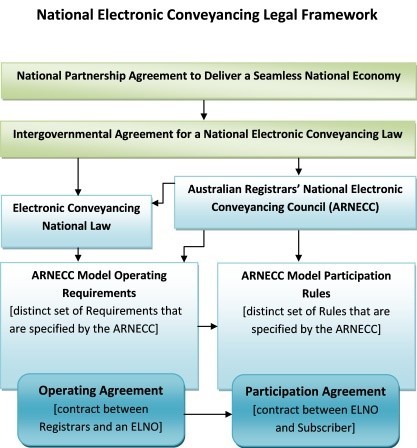ARNECC, ELN, ELNO, ECNL, PEXA – The Alphabet of Electronic Conveyancing
A recent cyber-attack incident against a property settlement transaction processed through the PEXA network has raised concerns over the transition from the traditional paper-based settlement process to electronic conveyancing. A number of cyber security experts have expressed their concerns about the cyber security practices underpinning the electronic settlement process. In response, PEXA announced the introduction of additional security measures and a consumer guarantee in line with recommendations from these experts. However, there is still a general lack of knowledge of the legal framework and the role of PEXA around electronic conveyancing.
In this article, we explain the basics of electronic conveyancing and how similar platforms were introduced overseas.
The Building Blocks of Electronic Conveyancing Platforms
The legal framework surrounding the new way of conveyancing was developed by the Australian Registrars’ National Electronic Conveyancing Council (ARNECC) under the Electronic Conveyancing National Law (ECNL) as depicted below:

All participants in the electronic conveyancing process including lawyers, real estate agents, conveyancers, banks, and financial service providers are bound by the ARNECC Model Participation Rules subject to the Operating Requirements, including the insurance rules.
An essential building block in the ECNL is the Electronic Lodgment Network (ELN) operated by the Electronic Lodgment Network Operator (ELNO). ELN is a network established to create and electronically lodge registry instruments and other electronic documents with the jurisdiction’s Land Registry. While Property Exchange Australia (PEXA) is currently the only authorised ELNO, Purcell Partners and Sympli Australia are also in the process of applying to become approved ELNOs. In addition, InfoTrack and Lextech have also announced their intentions to apply to become ELNOs.
It is important to understand that PEXA, as an ELNO, supports an ecosystem of value-added third-party service providers known as ‘PEXA Sponsors’. PEXA Sponsors are information brokers or conveyancing software providers adding a number of services that PEXA does not offer, such as land title and company searches.
One of these sponsors is InfoTrack which offers a full range of services around electronic conveyancing. InfoTrack CEO John Ahern explained in his blog post ‘8 common eConveyancing myths dispelled’ that “… PEXA’s platform is only the final step of the e-Conveyancing process – electronic settlement …”. A key insight from John is that the conveyancing process is transitioning from paper-based system at many levels right from the start of the composition of the ‘Contract for Sale’. While technology is a key enabler, participants are not required to be tech-savvy.
Experience and expertise of all the participants, from real estate agents to conveyancers, are still central to a secure and smooth transaction which cannot be replaced by technology. During the transition period, the ecosystem does and will continue to support a mix of paper-based and electronic processes. The public can be assured of the integrity and security of the ecosystem.
Electronic conveyancing experience in the UK
While electronic conveyancing is relatively new to Australia, paperless conveyancing is a reality overseas. Even though the differences between land registration systems (e.g. English land law versus Torrens title), it still gives us the opportunity to learn from failures elsewhere and avoid some generic pitfalls.
As the move towards electronic conveyancing is a global trend, there might be lessons to be learnt for the Australian implementation. For example, electronic conveyancing in the UK was mandated at the height of the dotcom boom in 2002.
The primary two drivers of the initiative were a shorter timescale of the conveyancing transaction and an improved rate of accuracy of the submitted documents. Back then, the full conveyancing process took 13 weeks to complete, and circa 50% of the paper-based applications at the Land Registry was defective. Several pilot projects were launched within the first years, which all failed due to limited interest. Eventually, a few platforms prevailed allowing us to peek into the security practices of them.
In parallel, numerous cases of conveyancing fraud were slowing down the transition to electronic conveyancing. Just like in Australia today, not only the home buyers were reporting six-digit losses back then, but the modus operandi of cybercriminals were also very similar. Fraudsters were typically gaining access to the conveyancers’ mailboxes to be able to tamper with payment instructions sent via plain emails.
As a response to these threats, the electronic conveyancing collaboration platform ‘Free2Convey’ boasts a secure messaging platform and anti-fraud tools to combat conveyancing fraud. Conveyancers can join a ‘deal room’, where they can upload and share documents securely between all parties. Its companion tool, ’Docs4Home’, offers two-factor authentication out-of-the-box to share and collaborate securely on conveyancing documentation. A competing platform ‘When You Move’ also offers similar security features to prevent email-based attacks.
In summary, electronic conveyancing, as well as conveyancing fraud, is not new. Emerging conveyancing platforms in Australia all should assess risks and take the appropriate and adequate security measures to protect buyers and homeowners from conveyancing fraud.
Conclusion
Given the NSW Government’s target of 100% electronic conveyancing by July 2019, this is an important area of reform where legal and cyber security practitioners must work together to support the vision of the government for the benefit of society. To this end, it is crucial that the public is informed of the basic facts to empower them to take full advantage of the capability of electronic conveyancing while protecting their financial well-being. As conveyancing fraud is a growing threat in Australia, cyber risks associated with electronic conveyancing should be identified and mitigated. Success stories and lessons learned are available overseas where electronic conveyancing was introduced earlier.
This article is co-authored by Gabor Szathmari and Denny Wan.
*** This is a Security Bloggers Network syndicated blog from Rainbow and Unicorn authored by Gabor. Read the original post at: https://blog.gaborszathmari.me/the-alphabet-of-electronic-conveyancing/





